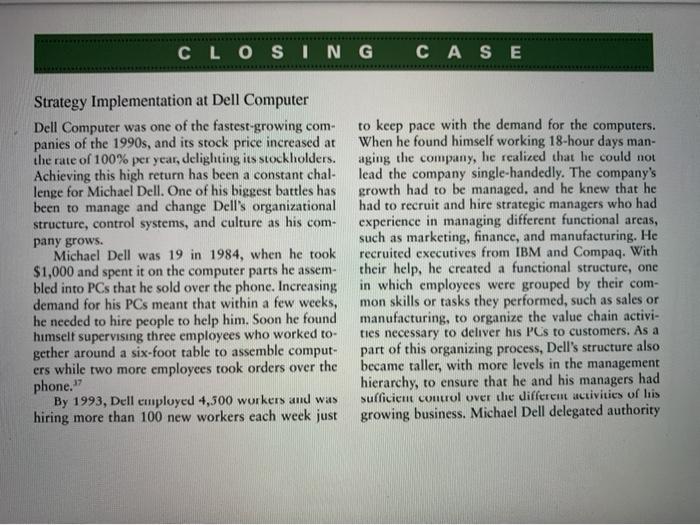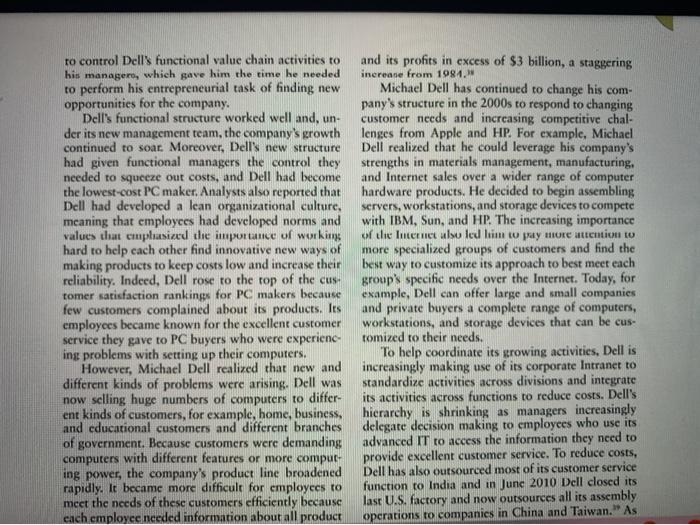Answered step by step
Verified Expert Solution
Question
1 Approved Answer
CLOSING Strategy Implementation at Dell Computer Dell Computer was one of the fastest-growing com- panies of the 1990s, and its stock price increased at



CLOSING Strategy Implementation at Dell Computer Dell Computer was one of the fastest-growing com- panies of the 1990s, and its stock price increased at the rate of 100% per year, delighting its stockholders. Achieving this high return has been a constant chal- lenge for Michael Dell. One of his biggest battles has been to manage and change Dell's organizational structure, control systems, and culture as his com- pany grows. Michael Dell was 19 in 1984, when he took $1,000 and spent it on the computer parts he assem- bled into PCs that he sold over the phone. Increasing demand for his PCs meant that within a few weeks, he needed to hire people to help him. Soon he found himself supervising three employees who worked to- gether around a six-foot table to assemble comput- ers while two more employees took orders over the phone." By 1993, Dell employed 4,500 workers and was hiring more than 100 new workers each week just CASE to keep pace with the demand for the computers. When he found himself working 18-hour days man- aging the company, he realized that he could not lead the company single-handedly. The company's growth had to be managed, and he knew that he had to recruit and hire strategic managers who had experience in managing different functional areas, such as marketing, finance, and manufacturing. He recruited executives from IBM and Compaq. With their help, he created a functional structure, one in which employees were grouped by their com- mon skills or tasks they performed, such as sales or manufacturing, to organize the value chain activi- ties necessary to deliver his PCs to customers. As a part of this organizing process, Dell's structure also became taller, with more levels in the management hierarchy, to ensure that he and his managers had sufficient control over the different activities of his growing business. Michael Dell delegated authority to control Dell's functional value chain activities to his managero, which gave him the time he needed to perform his entrepreneurial task of finding new opportunities for the company. Dell's functional structure worked well and, un- der its new management team, the company's growth continued to soar. Moreover, Dell's new structure had given functional managers the control they needed to squeeze out costs, and Dell had become the lowest-cost PC maker. Analysts also reported that Dell had developed a lean organizational culture, meaning that employees had developed norms and values that emphasized the importance of working hard to help each other find innovative new ways of making products to keep costs low and increase their reliability. Indeed, Dell rose to the top of the cus- tomer satisfaction rankings for PC makers because few customers complained about its products. Its employees became known for the excellent customer service they gave to PC buyers who were experienc- ing problems with setting up their computers. However, Michael Dell realized that new and different kinds of problems were arising. Dell was now selling huge numbers of computers to differ- ent kinds of customers, for example, home, business, and educational customers and different branches of government. Because customers were demanding computers with different features or more comput- ing power, the company's product line broadened rapidly. It became more difficult for employees to meet the needs of these customers efficiently because each employee needed information about all product and its profits in excess of $3 billion, a staggering increase from 1981." Michael Dell has continued to change his com- pany's structure in the 2000s to respond to changing customer needs and increasing competitive chal- lenges from Apple and HP. For example, Michael Dell realized that he could leverage his company's strengths in materials management, manufacturing, and Internet sales over a wider range of computer hardware products. He decided to begin assembling servers, workstations, and storage devices to compete with IBM, Sun, and HP. The increasing importance of the Internet also led him to pay more attention to more specialized groups of customers and find the best way to customize its approach to best meet each group's specific needs over the Internet. Today, for example, Dell can offer large and small companies and private buyers a complete range of computers, workstations, and storage devices that can be cus- tomized to their needs. To help coordinate its growing activities, Dell is increasingly making use of its corporate Intranet to standardize activities across divisions and integrate its activities across functions to reduce costs. Dell's hierarchy is shrinking as managers increasingly delegate decision making to employees who use its advanced IT to access the information they need to provide excellent customer service. To reduce costs, Dell has also outsourced most of its customer service function to India and in June 2010 Dell closed its last U.S. factory and now outsources all its assembly operations to companies in China and Taiwan." As als of Strategic Mana ement making products to keep costs low and increase their reliability. Indeed, Dell rose to the top of the cus- tomer satisfaction rankings for PC makers because few customers complained about its products. Its employees became known for the excellent customer service they gave to PC buyers who were experienc- ing problems with setting up their computers. However, Michael Dell realized that new and different kinds of problems were arising. Dell was now selling huge numbers of computers to differ- ent kinds of customers, for example, home, business, and educational customers and different branches of government. Because customers were demanding computers with different features or more comput- ing power, the company's product line broadened rapidly. It became more difficult for employees to meet the needs of these customers efficiently because each employee needed information about all product features or all of Dell's thousands of different sales offers across its product range. By the late 1990s, Michael Dell moved to change his company to a market structure and created sepa- rate divisions, each geared to the needs of a different group of customers: a consumer division, a business division, and so on. In cach division, teams of em- ployees specialized in servicing the needs of one of these customer groups. This move to a more com- plex structure also allowed each division to de- velop a unique subculture that suited its tasks, and employees were able to obtain in-depth knowledge about the needs of their market that helped them to respond better to their customers' needs. So success- ful was this change in structure and culture that by 2000, Dell's revenues were more than $35 billion. best way to customize its approach to best meet each group's specific needs over the Internet. Today, for example, Dell can offer large and small companies and private buyers a complete range of computers, workstations, and storage devices that can be cus- tomized to their needs. To help coordinate its growing activities, Dell is increasingly making use of its corporate Intranet to standardize activities across divisions and integrate its activities across functions to reduce costs. Dell's hierarchy is shrinking as managers increasingly delegate decision making to employees who use its advanced IT to access the information they need to provide excellent customer service. To reduce costs, Dell has also outsourced most of its customer service function to India and in June 2010 Dell closed its last U.S. factory and now outsources all its assembly operations to companies in China and Taiwan." As a result of these moves, Dell's smaller U.S. workforce has become even more committed to finding ways to keep costs as low as possible while being responsive to its customers. All members of the organization are working to fight back and regain Dell's low-cost competitive advantage from rivals such as HP and Acer that have imitated its cost-saving strategies. Case Discussion Questions 1. Why has Dell moved to different kinds of organi- zational structures over time? 2. Has Dell's performance been improved? 3. Search the Internet to find out how Dell has been trying to increase its performance and how its competitors such as HP and Acer have also been working to improve theirs.
Step by Step Solution
★★★★★
3.49 Rating (152 Votes )
There are 3 Steps involved in it
Step: 1
Answer 1 Dell has moved to different kinds of organizational structures over time for the following reasons 1 To create a functional structure in whic...
Get Instant Access to Expert-Tailored Solutions
See step-by-step solutions with expert insights and AI powered tools for academic success
Step: 2

Step: 3

Ace Your Homework with AI
Get the answers you need in no time with our AI-driven, step-by-step assistance
Get Started


